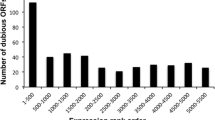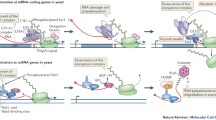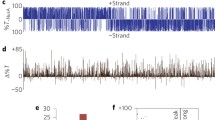Abstract
Transcriptional regulation depends on the appropriate set of positive and negative signals that provide correct gene expression. Studies in eukaryotic gene expression have shown NC2 to be a general repressor of transcription which blocks the interaction between TFIIB and TBP. However, during the last few years, NC2 has been found to bind the transcriptionally active promoters and interact with several positive transcription factors. These data suggested a controversial role of NC2 in transcription. Using in vitro transcription on a minimal LTR promoter of HIV-1, we show that removal of NC2 from HeLa nuclear extract increases the yield of transcripts, as well as unspecific transcription initiation in a template-amount-dependent manner. Fractions of HeLa nuclear extract containing NC2 can restore basal transcription repression and precise selection of the transcription initiation point. This points to a new role for NC2 as a repressor of inaccurate transcription initiation which allows specific transcription to take place.
Similar content being viewed by others
References
Kirn T.K., Zhao Y., Ge H., Bernstein R., Roeder R.G. 1995. TATA-binding protein residues implicated in a functional interplay between negative cofactor NC2 (Drl) and general factors TFIIA and TFIIB. J. Biol. Chem. 270, 10976–10981.
Mermelstein F., Yeung K., Cao J., Inostroza J.A., Erdjument-Bromage H., Eagelson K., Landsman D., Levitt P., Tempst P., Reinberg D. 1996. Requirement of a corepressor for Dr 1-mediated repression of transcription. Genes Dev. 15, 1033–1048.
Goppelt A., Stelzer G., Lottspeich F., Meisterernst M. 1996. A mechanism for repression of class II gene transcription through specific binding of NC2 to TBP-promoter complexes via heterodimeric histone fold domains. EMBO J. 15, 3105–3116.
Kamada K., Shu F., Chen H., Malik S., Stelzer G., Roeder R.G., Meisterernst M., Burley S.K. 2001. Crystal structure of negative cofactor 2 recognizing the TBP-DNA transcription complex. Cell. 106, 71–81.
Prelich G. 1997. Saccharomyces cerevisiae BUR6 encodes a DRAP1/NC2alpha homolog that has both positive and negative roles in transcription in vivo. Mol. Cell. Biol. 17, 2057–2065.
Gang Y., Prelich G. 2002. Direct stimulation of transcription by negative cofactor 2 (NC2) through TATA-binding protein (TBP). Proc. Natl. Acad. Sci. USA. 99, 12727–12732.
Willy P.J., Kobayashi R., Kadonaga J.T. 2000. A basal transcription factor that activates or represses transcription. Science. 290, 982–985.
Klejman M.P., Pereira L.A., van Zeeburg H.J., Gilfillan S., Meisterernst M., Tirnmers H.T. 2004. NC2alpha interacts with BTAF1 and stimulates its ATP-dependent association with TATA-binding protein. Mol. Cell Biol. 24, 10072–10082.
Castaño E., Gross P., Wang Z., Roeder R.G., Oelgeschlager T. 2000. The C-terminal domain-phosphorylated IIO form of RNA polymerase II is associated with the transcription repressor NC2 (Drl/DRAP1) and is required for transcription activation in human nuclear extracts. Proc. Natl. Acad. Sci. USA. 97, 7184–7189.
Denko N., Wernke-Dollries K., Johnson A.B., Hammond E., Chiang C.M., Barton M.C. 2003. Hypoxia actively represses transcription by inducing negative cofactor 2 (Drl/DrAPl) and blocking preinitiation complex assembly. J. Biol. Chem. 278, 5744–5749.
Iratni R., Yan Y.T., Chen C., Ding J., Zhang Y., Price S.M., Reinberg D., Shen M.M. 2002. Inhibition of excess nodal signaling during mouse gastrulation by the transcriptional corepressor DRAP1. Science. 298, 1996–1999.
Creton S., Svejstrup J.Q., Collart M.A. 2002. The NC2 alpha and beta subunits play different roles in vivo. Genes Dev. 16, 3265–3276.
Ikeda K., Halle J.P., Stelzer G., Meisterernst M., Kawakami K. 1998. Involvement of negative cofactor NC2 in active repression by zinc finger-homeodomain transcription factor AREB6. Mol. Cell Biol. 18, 10–18.
Dignam J.D., Martin P.L., Shaslry B.S., Roeder R.G. 1983. Eukaryotic gene transcription with purified components. Meth. Enzymol. 101, 582–598.
Castano E., Flores R.D., Zapata L.C. 2005. An easy approach for the purification of native TFIIH. J. Biochem. Biophys. Methods. 31, 207–213.
Inostroza J.A., Mermelstein F.H., Ha I., Lane W.S., Reinberg D. 1992. Drl, a TATA binding protein-associated phosphoprotein and inhibitor of class II gene transcription. Cell. 70, 477–489.
Author information
Authors and Affiliations
Additional information
Published in Russian in Molekulyarnaya Biologiya, 2006, Vol. 40, No. 2, pp. 284–288.
This article was translated by the authors.
Rights and permissions
About this article
Cite this article
Castaño, E., Rodríguez-Zapata, L., Rodriguez, H.P. et al. Native NC2 selectively represses incorrect transcription initiation. Mol Biol 40, 246–250 (2006). https://doi.org/10.1134/S0026893306020105
Received:
Issue Date:
DOI: https://doi.org/10.1134/S0026893306020105




